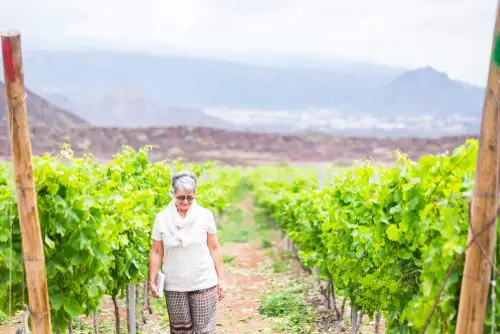 Paul Smith, our Financial Director, has been on a mission in Bordeaux to discover new wines, chateaux and wine makers. This is the third in a series of blogs about his trip and his discoveries.
Paul Smith, our Financial Director, has been on a mission in Bordeaux to discover new wines, chateaux and wine makers. This is the third in a series of blogs about his trip and his discoveries.
Bordeaux is full of fairytales in more ways than one. There are ‘Cinderella’ chateaux that rise from neglected obscurity to fame and fortune and there are also chateaux that are ‘Sleeping Beauties’. It was one such ‘Sleeping Beauty,’ named Chateau de Rouillac, that Laurent Cisneros happened to fall in love with back in 2009.
Laurent had been a top footballer for Angouleme and Cannes, playing alongside Zidane. He had always dreamt of owning his own chateau and smitten by Rouillac he sold his family business, DGS, to the Vaillant Group (Europe’s leading boiler manufacturers) in order to buy the chateau.
Rouillac’s previous owners had let the sleeping chateau lie virtually abandoned and her pedigree was long forgotten.
In fact the chateau has an impressive history – its wines once graced the dining tables of Emperor Napoleon III and King Albert 1st of Belgium.
Rouillac lies in Canejan in Pessac Leognan and the estate is one of the oldest properties in the area. In the 17th century it had been owned by a King’s Counsellor and then by a President of the Bordeaux parliament but it was in 1864 that the chateau’s history became forever linked to that of the man who literally changed the face of Paris.
At this point in time Rouillac was acquired by none other than Baron Haussmann (1809 – 1891). His name may not be well known outside his native France but he was the man who was responsible for rebuilding Paris and the twelve grand avenues radiating out from the Arc de Triomphe were one of his creations.
He was commissioned by Napoleon III to ‘modernise’ the old and dirty city; and his sweeping changes not only included the opera house and smart new public buildings but a new water supply, a gigantic system of sewers and new bridges.
The Baron also made his mark on Rouillac – he was passionate about horses and had the beautiful stables constructed for them that still stand today. His emblem stands in stone on the shield above the door as you enter the chateau.
The Baron was married to Octavia La Harpe, the daughter of a wine merchant in Bordeaux, who owned the nearby vineyards of Chateau de Cestas. He produced red wine at Rouillac, which impressed Napoleon III so much that he stayed at Rouillac in 1869, brought the wine to his Imperial Court and introduced it to King Albert 1st of Belgium.
Because of the Baron, horses form an integral part of the history of Rouillac and thanks to the Cisneros they have returned to the chateau once more. Laurent and his family are keen equestrians and share the Baron’s love of horses. The stables are home to dressage horses as well as show jumpers and shire horses plough the vineyards.
The stables are not the only part of Rouillac that has been returned to their former splendour. Laurent, his wife Sophie and his three daughters have invested everything into bringing this sleeping chateau back to life. A new winery has been built and the chateau buildings have been renovated. They regularly hold events and won the 2012 Best of Wine Tourism Awards last year.
Woodland has been cleared with the intention of planting an extra 5 acres of additional vines to increase production. Jean Christophe Barron has been brought in as Technical Director and Eric Boissenot is now the consultant oenologist.
Laurent has adopted a policy of sustainable agricultural methods and is working towards a certification for the “High Environmental Value” label. No chemical pesticides or herbicides are used, only organic methods of controling pests and diseases. Lime trees have also been replanted as their blossom attracts the bees.
With this kind of momentum behind it Rouillac’s wines are undoubtedly ones to look out for. It seems that Laurent has succeeded in waking up his chateau and the future is packed with new possibilities.
Paul Smith, our Financial Director, has been on a mission in Bordeaux to discover new wines, chateaux and wine makers. This is the third in a series of blogs about his trip and his discoveries.
Bordeaux is full of fairytales in more ways than one. There are ‘Cinderella’ chateaux that rise from neglected obscurity to fame and fortune and there are also chateaux that are ‘Sleeping Beauties’. It was one such ‘Sleeping Beauty,’ named Chateau de Rouillac, that Laurent Cisneros happened to fall in love with back in 2009.
Laurent had been a top footballer for Angouleme and Cannes, playing alongside Zidane. He had always dreamt of owning his own chateau and smitten by Rouillac he sold his family business, DGS, to the Vaillant Group (Europe’s leading boiler manufacturers) in order to buy the chateau.
Rouillac’s previous owners had let the sleeping chateau lie virtually abandoned and her pedigree was long forgotten. In fact the chateau has an impressive history – its wines once graced the dining tables of Emperor Napoleon III and King Albert 1st of Belgium.
Rouillac lies in Canejan in Pessac Leognan and the estate is one of the oldest properties in the area. In the 17th century it had been owned by a King’s Counsellor and then by a President of the Bordeaux parliament but it was in 1864 that the chateau’s history became forever linked to that of the man who literally changed the face of Paris.
He was commissioned by Napoleon III to ‘modernise’ the old and dirty city; and his sweeping changes not only included the opera house and smart new public buildings but a new water supply, a gigantic system of sewers and new bridges.
The Baron also made his mark on Rouillac – he was passionate about horses and had the beautiful stables constructed for them that still stand today. His emblem stands in stone on the shield above the door as you enter the chateau.
The Baron was married to Octavia La Harpe, the daughter of a wine merchant in Bordeaux, who owned the nearby vineyards of Chateau de Cestas. He produced red wine at Rouillac, which impressed Napoleon III so much that he stayed at Rouillac in 1869, brought the wine to his Imperial Court and introduced it to King Albert 1st of Belgium.
Because of the Baron, horses form an integral part of the history of Rouillac and thanks to the Cisneros they have returned to the chateau once more. Laurent and his family are keen equestrians and share the Baron’s love of horses. The stables are home to dressage horses as well as show jumpers and shire horses plough the vineyards.
The stables are not the only part of Rouillac that has been returned to their former splendour. Laurent, his wife Sophie and his three daughters have invested everything into bringing this sleeping chateau back to life.
A new winery has been built and the chateau buildings have been renovated. They regularly hold events and won the 2012 Best of Wine Tourism Awards last year.
The chateau produces both red and white wine (there is one single plot covering 40 acres for the red grapes and 5 acres for the white). Laurent produces a Second Wine, Le Baron de Rouillac and also Le Dada de Rouillac ( a nod to their love of horses).
Woodland has been cleared with the intention of planting an extra 5 acres of additional vines to increase production. Jean Christophe Barron has been brought in as Technical Director and Eric Boissenot is now the consultant oenologist.
Laurent has adopted a policy of sustainable agricultural methods and is working towards a certification for the “High Environmental Value” label. No chemical pesticides or herbicides are used, only organic methods of controling pests and diseases. Lime trees have also been replanted as their blossom attracts the bees.
With this kind of momentum behind it Rouillac’s wines are undoubtedly ones to look out for. It seems that Laurent has succeeded in waking up his chateau and the future is packed with new possibilities.

